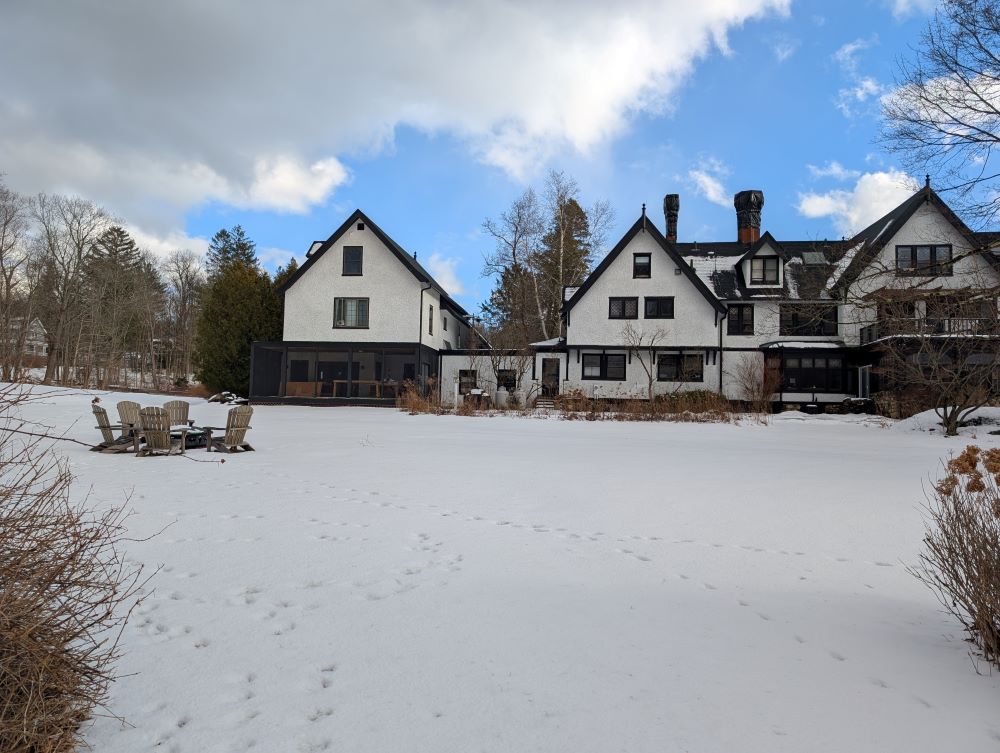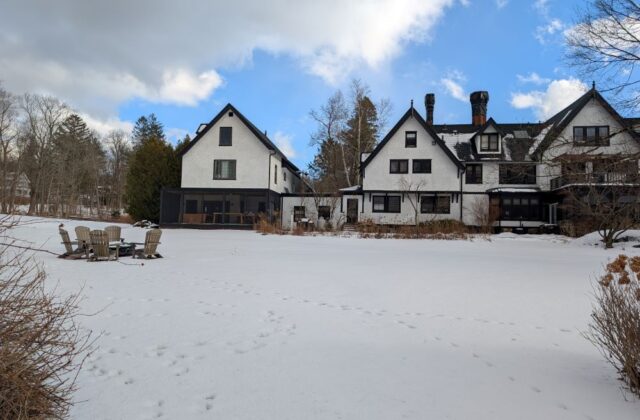Proposed Manor House Expansion Draws Large Crowd
Many differing views on effect of change in town center
By Susan MacEachron

Norfolk residents filled the Botelle School Hall of Flags on a very cold evening on Tuesday, Jan. 14, to attend the Planning & Zoning (P&Z) public hearing regarding a modification to the special permit granted in 1996 to the property known as the Manor House, at 69 Maple Avenue.
Chris Schaut, P&Z chair, noting the large attendance, advised that the hearing would run from 6:30 until 9 p.m. to accommodate comments from the public.
The owners, Three Stewards Real Estate LLC, brought a team of experts to describe their proposed plans for a day spa to augment their current activities as a country inn. After the detailed presentation, members of the public voiced both support and disapproval of the plans. Due to additional submissions from the Manor House that had been received by the P&Z only that week, the commission said they would need additional time and voted to continue the public hearing to Tuesday, Feb. 11.
Representing Three Stewards, Attorney Andrea Gomes, a partner with Hinckley Allen in Hartford, began by introducing the owners, Rachel Roth, Richard Restifo and Nathan Roth; Robert Gilchrest and George Johannesen of Allied Engineering Associates in North Canaan; Jared Hite of Solli Engineering in Monroe; and Rob White of Rob White Architect in Bethany.
Gomes next noted the intense public interest in the proposal and mentioned several letters in support that she described as “thoughtful.” Schaut said all letters would be read into the public record, but only after people in the room had a chance to speak.
Gomes referenced the “robust” website created in opposition to the proposed plans and said it had “fanned the flames of opposition.” She expressed her client’s position that the large parking area is dictated by the site and, further, that the requested 45 parking spaces are the minimum required by the zoning regulations. Gomes stated that the Manor House’s owners believe that its designation as a country inn is permitted within the village residential zone and that these uses can legally continue without any additional approval.
The validity of the 1996 special permit was questioned later in the meeting when members of the public had the opportunity to speak.
Gomes next reported that the Norfolk fire marshal said the Manor House could accommodate a restaurant with seating for 44. She said that Wetlands Enforcement Officer Stacey Sefcik had agreed there was no need for review or approval by the Inland Wetlands Agency, as the proposed plans do not infringe on any wetlands on the property. Gomes said she and Gilchrest had attended the Jan. 13 Conservation Commission meeting to explain the engineering plans for controlling water runoff from the proposed additions to the site.
According to Gomes, although the inn has ten bedrooms, two have fire safety issues and are not allowed as guest rooms. She said the 1996 permit allows up to 25 rooms for overnight stays and events for up to 150 guests.
P&Z counsel, Daniel Casagrande of Cramer & Anderson LLP, stated that the changes being proposed are the focus of the meeting and it is not an occasion to re-litigate the validity of the 1996 special permit. He said the question is whether the proposed changes trigger concerns based on general standards for special permits.
Next, Rachel Roth of Orange, Conn., a Three Stewards owner, spoke. She explained that a large historic building on a five-acre site is expensive to maintain, and it needs modernization and beautification. She said that she shifted her plans from expanding the scale of events at the inn based on feedback from the neighbors and that she believes the proposed modifications would be the quietest and have the least impact. Roth said she had made an earnest effort to present her plans, had numerous private conversations and had taken the feedback to heart. She said she believes much of the controversy is due to misunderstanding, but the “personal attacks” were upsetting. She noted that she has invested nearly $2 million in the Manor House and intends to move here for the next stage of her career.
Lead designer and project manager Gilchrest presented the proposed changes to the site, planned in three phases. Phase 1 includes a new garage, a heated pool, sauna, a cold plunge pool and a heated patio. The entrance driveway will be widened and refurbished, and parking for 25 vehicles along Maple Ave. will be added in phase 2. A driveway exiting onto Mills Way will be constructed. In addition, a koi pond, a lily pond and two rain gardens will be created. The final phase will include a new 1,500 square-foot recreation building, two Nordic-style guest cabins, a beverage station and parking for 20 additional vehicles along the Mills Way side of the property.
Gilchrest described the proposed lighting and noted that the 12-foot pole lights are the same as those recently installed at town hall which are designed to minimize light pollution. He said the walkways will be illuminated by bollard lighting with motion detectors that will dim to 20 percent capacity when no one is passing by. He characterized the look as a “glow” in the middle of the night. Gilchrest said landscaping plans include a mix of native plantings and ornamental plants selected for seasonal interest and color. He highlighted the plan to use the Maple Ave entrance for incoming traffic and Mills Way for cars leaving the property.
After the 1.5-hour presentation by Three Stewards, Schaut opened the meeting to public comment and said there would be a three-minute limit per person.
Joe Kelly, of 72 and 76 Maple Ave., said he was speaking on behalf of a number of the neighbors. He described the proposal as a big undertaking and a significant change in the operation of the inn. He noted that a day spa would be a new, distinct business from an inn and that the business, per zoning, belongs in the town’s business district. He expressed his concern that the scale and scope of the proposed new amenities would permanently alter the residential character of the neighborhood, emphasizing the 33-foot tall addition, extensive parking areas and lighting the new activities will require.
Sara Minard, of 31 Pettibone Lane, summarized key points from a memo she provided to P&Z members written by Paul Kennedy, a retired partner of White & Case, a global law firm headquartered in New York City. Kennedy noted that the 1996 special permit application did not include the required site plan and therefore is defective and should be considered void. Minard briefly described Kennedy’s points concerning regulations governing special permits, commercial activities allowed in residential zones and personal services establishments. As a day spa is not on the list of commercial activities permitted in Norfolk’s residential zone, Kennedy believes that current regulations prohibit it.
He also noted that regulations governing the granting of special permits require P&Z to consider the essential purpose of Norfolk’s zoning rules, which is to protect property values and disfavor uses that result in any detriment to neighbors.
A total of 15 people expressed their views and were about evenly split in favor and opposed. P&Z members were given a chance to ask for specific additional information they would like the applicant to provide at the meeting on Feb. 11.
At the start of the meeting, Vice Chair Schaut was elected as the new P&Z chair, replacing Tom Fahsbender, who resigned in December. At the end of the meeting, Edward Barron was elected as vice chair.
The full Manor House application can be viewed at https://norfolkct.org/special_meetings/application-for-a-site-plan-modification/

